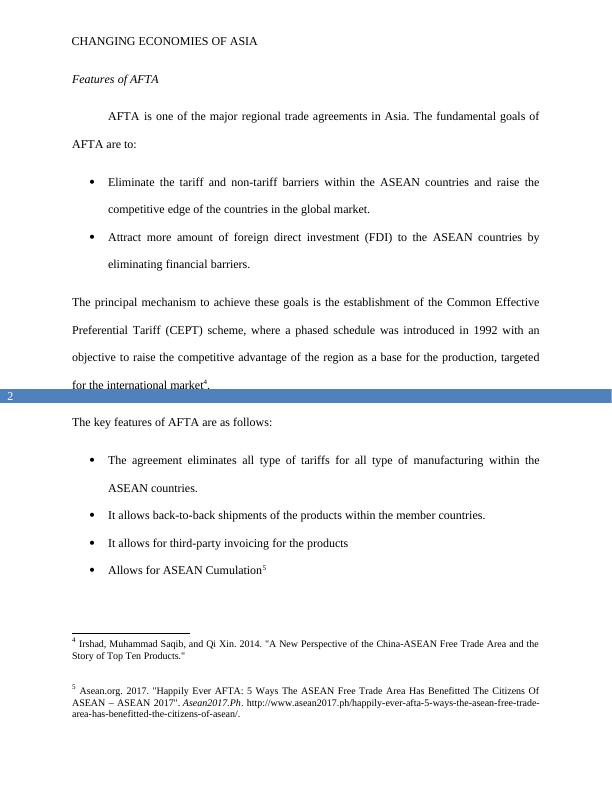Economics Assignment | Changing Economies of Asia
Added on 2020-05-16
14 Pages2571 Words38 Views
Running head: CHANGING ECONOMIES OF ASIA
ASEAN Free Trade Area (AFTA) and Its Impact on the Member Countries
Name of the Student:
Name of the University:
Author note:
ASEAN Free Trade Area (AFTA) and Its Impact on the Member Countries
Name of the Student:
Name of the University:
Author note:

CHANGING ECONOMIES OF ASIA
1
Introduction
The developing countries of Asia have experienced development over the past few
decades, especially after the era of global trade liberalization, due to the existence of various
regional trade agreements (RTAs) among the countries. There are many RTAs in Asia that cover
the developing countries in many ways, with the major objective of promoting the overall
economic development of the signatory countries. World’s half production and consumption
market is presented by the Asian countries and the RTAs play a vital role in determining the
economic stability and growth of that region1. The regional trade agreements have benefitted the
signatory countries in economic growth and development, economic and political relations,
trade, investment, services, industry and social welfare.
ASEAN Free Trade Area (AFTA) is a regional trade agreement by the Association of
Southeast Asian Nations (ASEAN), established to support the local manufacturing industry in all
the ASEAN countries. The agreement was signed in Singapore in January 19922. During the
establishment, there were only six members in this agreement, namely, Indonesia, Singapore,
Thailand, Philippines, Malaysia and Brunei. Vietnam, Laos, Myanmar and Cambodia joined the
agreement in 1995, 1997 and 1999 respectively. Thus, currently, the agreement covers the above
mentioned 10 countries and has contributed immensely in the growth of those countries. It
created a regional market for almost 500 million people3. The features and impact of the AFTA
on the signatory countries is the thesis of this following essay.
Discussion
1 Kawai, Masahiro, and Ganeshan Wignaraja. 2013. "Patterns of free trade areas in Asia."
2 Aggarwal, Vinod, and Shujiro Urata, eds. 2013. Bilateral trade agreements in the Asia-Pacific: Origins, evolution,
and implications. Routledge.
3 DeRosa, Dean A. 2012. "The ASEAN free trade area plan and intra-regional trade in developing Asia."
1
Introduction
The developing countries of Asia have experienced development over the past few
decades, especially after the era of global trade liberalization, due to the existence of various
regional trade agreements (RTAs) among the countries. There are many RTAs in Asia that cover
the developing countries in many ways, with the major objective of promoting the overall
economic development of the signatory countries. World’s half production and consumption
market is presented by the Asian countries and the RTAs play a vital role in determining the
economic stability and growth of that region1. The regional trade agreements have benefitted the
signatory countries in economic growth and development, economic and political relations,
trade, investment, services, industry and social welfare.
ASEAN Free Trade Area (AFTA) is a regional trade agreement by the Association of
Southeast Asian Nations (ASEAN), established to support the local manufacturing industry in all
the ASEAN countries. The agreement was signed in Singapore in January 19922. During the
establishment, there were only six members in this agreement, namely, Indonesia, Singapore,
Thailand, Philippines, Malaysia and Brunei. Vietnam, Laos, Myanmar and Cambodia joined the
agreement in 1995, 1997 and 1999 respectively. Thus, currently, the agreement covers the above
mentioned 10 countries and has contributed immensely in the growth of those countries. It
created a regional market for almost 500 million people3. The features and impact of the AFTA
on the signatory countries is the thesis of this following essay.
Discussion
1 Kawai, Masahiro, and Ganeshan Wignaraja. 2013. "Patterns of free trade areas in Asia."
2 Aggarwal, Vinod, and Shujiro Urata, eds. 2013. Bilateral trade agreements in the Asia-Pacific: Origins, evolution,
and implications. Routledge.
3 DeRosa, Dean A. 2012. "The ASEAN free trade area plan and intra-regional trade in developing Asia."

CHANGING ECONOMIES OF ASIA
2
Features of AFTA
AFTA is one of the major regional trade agreements in Asia. The fundamental goals of
AFTA are to:
Eliminate the tariff and non-tariff barriers within the ASEAN countries and raise the
competitive edge of the countries in the global market.
Attract more amount of foreign direct investment (FDI) to the ASEAN countries by
eliminating financial barriers.
The principal mechanism to achieve these goals is the establishment of the Common Effective
Preferential Tariff (CEPT) scheme, where a phased schedule was introduced in 1992 with an
objective to raise the competitive advantage of the region as a base for the production, targeted
for the international market4.
The key features of AFTA are as follows:
The agreement eliminates all type of tariffs for all type of manufacturing within the
ASEAN countries.
It allows back-to-back shipments of the products within the member countries.
It allows for third-party invoicing for the products
Allows for ASEAN Cumulation5
4 Irshad, Muhammad Saqib, and Qi Xin. 2014. "A New Perspective of the China-ASEAN Free Trade Area and the
Story of Top Ten Products."
5 Asean.org. 2017. "Happily Ever AFTA: 5 Ways The ASEAN Free Trade Area Has Benefitted The Citizens Of
ASEAN – ASEAN 2017". Asean2017.Ph. http://www.asean2017.ph/happily-ever-afta-5-ways-the-asean-free-trade-
area-has-benefitted-the-citizens-of-asean/.
2
Features of AFTA
AFTA is one of the major regional trade agreements in Asia. The fundamental goals of
AFTA are to:
Eliminate the tariff and non-tariff barriers within the ASEAN countries and raise the
competitive edge of the countries in the global market.
Attract more amount of foreign direct investment (FDI) to the ASEAN countries by
eliminating financial barriers.
The principal mechanism to achieve these goals is the establishment of the Common Effective
Preferential Tariff (CEPT) scheme, where a phased schedule was introduced in 1992 with an
objective to raise the competitive advantage of the region as a base for the production, targeted
for the international market4.
The key features of AFTA are as follows:
The agreement eliminates all type of tariffs for all type of manufacturing within the
ASEAN countries.
It allows back-to-back shipments of the products within the member countries.
It allows for third-party invoicing for the products
Allows for ASEAN Cumulation5
4 Irshad, Muhammad Saqib, and Qi Xin. 2014. "A New Perspective of the China-ASEAN Free Trade Area and the
Story of Top Ten Products."
5 Asean.org. 2017. "Happily Ever AFTA: 5 Ways The ASEAN Free Trade Area Has Benefitted The Citizens Of
ASEAN – ASEAN 2017". Asean2017.Ph. http://www.asean2017.ph/happily-ever-afta-5-ways-the-asean-free-trade-
area-has-benefitted-the-citizens-of-asean/.

CHANGING ECONOMIES OF ASIA
3
The major difference of AFTA and EU is that, AFTA does not impose a common
external tariff on the imports. However, the members are allowed to impose tariffs on the
imports from countries outside ASEAN, depending on the national schedules. Goods, originated
in the ASEAN, are subject to 0-5% of tariff and the newer members are given extra time for
implementing the reduced rates of tariff6. There are three categories for tariff reduction, namely,
temporary exclusions, sensitive agricultural goods and general exceptions.
The CEPT is applied only on the products originated in the ASEAN countries. The rule
of origin allows for 40% of the FOB for local ASEAN content and value of inputs from various
ASEAN members are added together to meet the 40% threshold7. Administration of the
agreement is handled by the national trade and customs authorities in every ASEAN countries.
Impact of AFTA on the participant countries
The ASEAN Free Trade Area (AFTA) provides many benefits for the economic welfare
of the participating nations. The agreement focuses on the reformation of the tariff rates
prevailing in the ASEAN countries and its considerable positive impact on the trade creation for
a wide range of products in that region.
AFTA is the measure for promoting the intra-trade among the member countries of
ASEAN. It is found that, the elasticity of the reduction of tariff on the imported goods is quite
larger than that on the exported goods. At the same time, the effects of trade creation for the old
6 Mingst, Karen A., and Ivan M. Arreguín-Toft. 2013. Essentials of International Relations: Sixth International
Student Edition. WW Norton & Company.
7 Kawai, Masahiro, and Ganeshan Wignaraja. 2013. "Patterns of free trade areas in Asia."
3
The major difference of AFTA and EU is that, AFTA does not impose a common
external tariff on the imports. However, the members are allowed to impose tariffs on the
imports from countries outside ASEAN, depending on the national schedules. Goods, originated
in the ASEAN, are subject to 0-5% of tariff and the newer members are given extra time for
implementing the reduced rates of tariff6. There are three categories for tariff reduction, namely,
temporary exclusions, sensitive agricultural goods and general exceptions.
The CEPT is applied only on the products originated in the ASEAN countries. The rule
of origin allows for 40% of the FOB for local ASEAN content and value of inputs from various
ASEAN members are added together to meet the 40% threshold7. Administration of the
agreement is handled by the national trade and customs authorities in every ASEAN countries.
Impact of AFTA on the participant countries
The ASEAN Free Trade Area (AFTA) provides many benefits for the economic welfare
of the participating nations. The agreement focuses on the reformation of the tariff rates
prevailing in the ASEAN countries and its considerable positive impact on the trade creation for
a wide range of products in that region.
AFTA is the measure for promoting the intra-trade among the member countries of
ASEAN. It is found that, the elasticity of the reduction of tariff on the imported goods is quite
larger than that on the exported goods. At the same time, the effects of trade creation for the old
6 Mingst, Karen A., and Ivan M. Arreguín-Toft. 2013. Essentials of International Relations: Sixth International
Student Edition. WW Norton & Company.
7 Kawai, Masahiro, and Ganeshan Wignaraja. 2013. "Patterns of free trade areas in Asia."

End of preview
Want to access all the pages? Upload your documents or become a member.
Related Documents
International Business Assignment - ASEANlg...
|11
|3050
|279
Asia-Pacific Trade Agreement and Its Impact on the Participant Countrieslg...
|15
|2656
|455
Asean free trade area (PDF)lg...
|11
|2771
|104
THE ECONOMICS ASSIGNMENTlg...
|12
|3453
|23
Impact of Trade Blocs on Maritime Transport.lg...
|10
|1581
|11
Entrepreneur and Small Business Management.lg...
|8
|2037
|12
